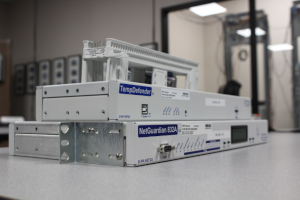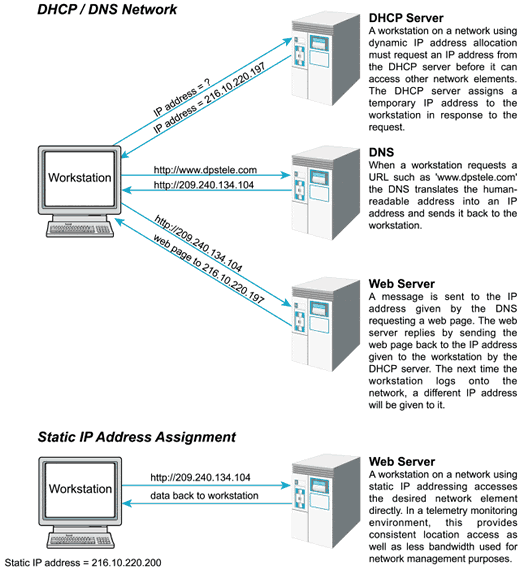Check out our White Paper Series!
A complete library of helpful advice and survival guides for every aspect of system monitoring and control.
1-800-693-0351
Have a specific question? Ask our team of expert engineers and get a specific answer!
Sign up for the next DPS Factory Training!

Whether you're new to our equipment or you've used it for years, DPS factory training is the best way to get more from your monitoring.
Reserve Your Seat Today Previous:Building Access System
Previous:Building Access System
Part 1 | Part 2
In our continuing protocol tutorial series, we now turn our focus from SNMP to a broader yet critical element of network management - IP addressing.

An IP address is the number that points to an element identity on a network. Just as your cell phone has a unique number assigned to it so it can receive and send calls, network elements have an identifying number called an IP address (Internet Protocol Address). In fact, that Smart Phone you use to surf the web has one assigned to it, but you will most likely never see it unless you look for it.
Just as your phone number is vital to anyone looking to contact you by phone, the IP address of a network element is vital to the connection of those elements within the network. The basic rule is simple: every network element must have a unique IP address. IP addresses can be assigned dynamically - on an as needed basis, or statically - usually on a permanent basis. Let's look at the differences between these two and why it matters.
Static IP addresses are just that: Static. They rarely change. Just like your name, once a static IP address is assigned a network element, it remains there until a decision is made to change the address for some reason. At this time, the basic IP address structure is a 12 number address configured in this pattern: xxx.xxx.xxx.xxx. So, for example, a network element might have a static IP address like 209.134.004.168. Referencing that address on the network would always point to that network element, just like your phone number always refers to your phone. The advantage of a static IP address primarily is the speed at which it can be referenced. Since the number never changes, and always refers to the same network element, it can be immediately accessed with no overhead processing.
Now consider the opposite of static IP assignments: DHCP, or Dynamic Host Configuration Protocol. As you can guess from its name, DHCP is dynamic. The IP address of different network elements are assigned to it as they come online by a server. This allows for IP addresses to be managed efficiently by providers with a large user base, because not all of the IP addresses are allocated at one time. A DHCP server allows a dynamic assignment of IP addresses in a system to those network elements that require them at a given time.
In order to be functional, a DHCP server uses a system to track and look up IP address information that relates to the active network elements. One of the tools that allow this translation is the Domain Name System or DNS. The DNS is like a card catalog in the library: it identifies the proper location of a network element and points network traffic to it when required. Surfing the internet makes extensive use of these two protocols. When you log onto the internet, DHCP is used to assign an IP address to your connection. When you enter a WWW address in your browser address bar or select a human-readable link on a web page, DNS is used to turn your URL request into an IP address for transmission. This process of looking up IP addresses and routing traffic to them requires some overhead processing and time, so in networks that do not require it, static IP assignments are often used.
Static assignment of IP addresses eliminates the network traffic associated with DHCP/DNS and locks an IP element into a specific address to provide a consistent IP target. Telemetry monitoring masters can then be told precisely where the element is located by entering the IP address. You can observe this effect by replacing a typical WWW reference with its direct IP address if you know it. For example, enter "209.240.134.104" in your browser address bar and, with no DNS overhead, you will reach the same web page you would reach by entering www.dpstele.com.

When considering which IP addressing method to use for alarm monitoring, please know that using DHCP IP addressing isn't the smartest solution. Let's consider what this will mean if you decide to use DHCP. You'll be wasting your time configuring your RTUs to report alarms to your master (i.e., T/Mon) with a specific IP address, knowing that it'll change. The DHCP lease for your master's IP address will then expire within a week or so. As a result, your master will be given a new IP address. While all of this is happening, your RTUs will still be sending alarms to the specific IP address from your initial configuration. Because your master now has a new IP address, it will fail to receive the alarms. You'll then have to waste more time configuring your RTUs to send alarms to this new IP address, knowing that it'll change again once the DHCP lease expires. This is equivalent to changing your phone number every week and notifying everybody in your contacts. It's not necessary and wastes time! It will not work!
Instead, static IP addresses are used in telemetry monitoring. You'll only have to configure your RTUs once and know that your master station will receive the alarms. Your IP address will never change unless you decide to change it for some reason. Your master will be able to receive the alarms from your RTUs without failing due to a change in IP address as with DHCP. You'll avoid the hassle of configuring your RTUs all over again because your master's IP address won't change. As a result, you'll have industrial control over your network with your IP addresses locked down and remaining the same. Your static IP addresses will make sure your alarms are received by your designated master.
We've established static IP addresses as the preferred method of Internet Protocol (IP) for communication. But have you ever wondered how a remote site with no Ethernet can send alarms to a master station? What about sites with T1 or fiber connections? How are their alarms sent to their master station?
First and foremost, you need a RTU that can support T1 or fiber connectivity. Fortunately, there are RTUs with T1 or fiber interfaces that can provide LAN to the devices at your remote sites. Let's take a look at these connections.
New developments in network monitoring have been made for remote sites that only have a T1 connection. RTUs like the NetGuardian 216T and NetGuardian 240T can provide your remote site with a T1 connection for transmitting alarm data.
Developments have also been made for remote sites that already have an established fiber connection. The NetGuardian 216F provides a cost-effective way to provide fiber connectivity to your remote site.
It is important to plan the structure regarding your remote sites when using static IP addressing. You'll want to avoid having two or more master station being assigned with the same static IP address. You don't want to waste your time or money deploying an unorganized solution that could've simply been fixed through planning. Bad planning or no planning at all can result in more truck rolls, windshield time, and spending more in the future to correct your mistakes.